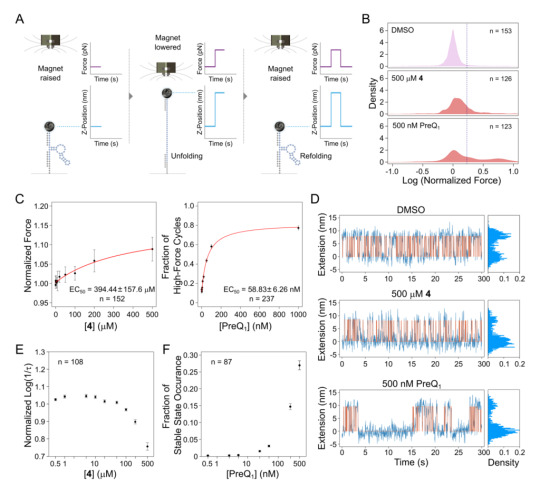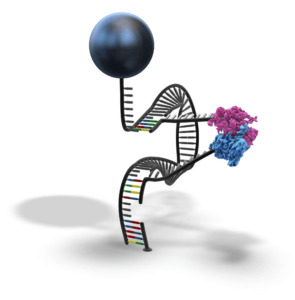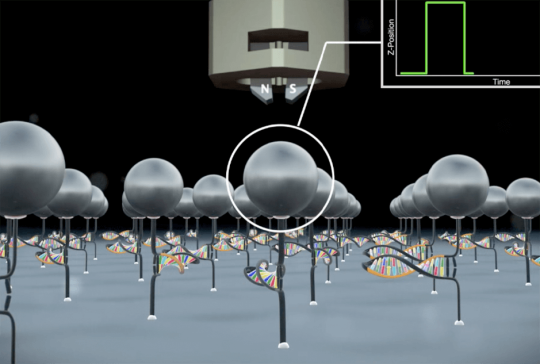#DepixusTechnology
Text
Explore Drugs Targeting RNA Riboswitches with Magna - Depixus

We’ve been working with Dr Jay Schneekloth, a leading expert in RNA-targeted drug discovery, to use our MAGNA™ technology to probe the interactions between the PreQ1 bacterial riboswitch and its natural ligand or a synthetic small molecule.
In a paper published as a preprint on bioRxiv and submitted for publication in a high impact journal, we showed how MAGNA provided novel insights into the distinct mechanisms of action of different ligands upon the target RNA at single molecule resolution.
What is the PreQ1 bacterial riboswitch?
Riboswitches are structured sequences of RNA that are commonly found in the 5′ untranslated regions of bacterial mRNAs and help to control metabolic pathways. They work through direct binding of a ligand such as a metabolite to the riboswitch, which induces a conformation change to their secondary structure and alters gene expression.
The PreQ1 riboswitch regulates downstream gene expression for the biosynthesis of queuosine in response to a metabolite called PreQ1 (7-aminomethyl-7-deazaguanine). Upon binding of PreQ1 the RNA changes into a shape known as a pseudoknot, which alters gene expression at either the transcriptional or translational level.
The ability of riboswitches to modulate bacterial gene expression in response to small molecules such as metabolites makes them an attractive group of novel antibacterial drug targets.
Using MAGNA to explore RNA-ligand interactions
Based on magnetic force spectroscopy, MAGNA is the first technology for exploring dynamic molecular interactions in real time from up to thousands of individual molecules. Here, we used it to probe the interactions between the PreQ1 riboswitch RNA from Bacillus subtilis (Bsu) and its natural ligand, PreQ1, or a synthetic ligand named Compound 4.
MAGNA allows us to precisely measure the effects of applying constant or gradually changing (ramped) forces to hundreds of immobilized riboswitch RNAs simultaneously (Figure 1A). This enabled us to capture the exact point at which each RNA molecule changes conformation.
We found that both PreQ1 and Compound 4 stabilized the riboswitch RNA structure, requiring more force to unfold it (Figure 1B). We were also able to explore the concentration dependency of their effects (Figure 1C, E, F).

Figure 1: (A) Overview of MAGNA as a single-molecule platform for exploring the interactions of bioactive small molecule ligands with their target RNA structures in real-time (B) Unfolding force distributions of the Bsu PreQ1 riboswitch aptamer in control (DMSO), Compound 4 and PreQ1 ligand conditions (C) Dose-response curve for the change in unfolding of the aptamer in the presence of 4 and PreQ1 (D) Raw traces of the constant-force experiments for control, 4 and PreQ1 of a single molecule with cumulative density histograms shown to the right. (E) The aptamer unfolding rate as a function of the concentration of 4 in constant force experiments. (F) The impact of PreQ1 ligand concentration on the occurrence probability of the stable folded state. n is the number of molecules analyzed. Taken from Parmar et al (bioRxiv, 2024).
In addition, Schneekloth and colleagues explored other structural aspects of the interaction between the riboswitch and various ligands, and their impact on gene expression in live bacterial cells. They were also able to show that Compound 4 could bind in a similar way to PreQ1 riboswitches from other species of bacteria, building up a fuller picture of the properties of this novel molecule.
Deeper insights for RNA-targeted drug development
Overall, the findings presented in the paper demonstrate that even though different ligands may appear to be the same in terms of RNA binding site and impact on gene expression, other factors including selectivity, mode of recognition, and impacts on both conformational kinetics and thermodynamics, can all play
a role in the abili
ty of a compound to modulate biological function. These subtle yet important distinctions may not be apparent using analytical methods that rely on surrogate outputs or bulk measurements.
MAGNA’s unique single molecule approach enabled the Schneekloth team to visualize the binding of a novel ligand to its target in real time and gather insights into the distinct mechanisms of action, which would not have been possible using other methods.
With MAGNA we now have a technology that can not only identify compounds that bind to RNA, but also directly reveal how they impact its structure and function at the level of individual molecules. And we can use it to generate detailed information about the kinetics and concentration dependence of ligand binding.
These results demonstrate the capabilities of MAGNA to deliver valuable data about individual dynamic molecular interactions at scale, supporting lead selection in the development of novel RNA-targeted therapeutics.
Read More here: https://depixus.com/using-magna-to-explore-drugs-targeting-rna-riboswitches/
#TechnologyIntroduction#InnovativeTechnology#DepixusTechnology#MAGNATechnology#MAGNAbiomolecularinteractions#MAGNAdrugdiscovery#MAGNAproteinproteininteractions#Biomolecularinteractions#Moleculebinding#Drugdiscovery#Proteinproteininteractions#Biophysics#Structuralbiology#Moleculardynamics#Computationalbiology#RNA#Riboswitches#depixus
0 notes
Text
How MAGNA™ Technology is Revolutionizing the Study of Biomolecular Interactions
In the world of science, understanding how molecules interact with each other is crucial for developing new drugs, diagnostics, and other life-saving technologies. However, traditional methods for studying these interactions are often time-consuming, expensive, and inaccurate.
MAGNA™ technology is a new and innovative approach that is revolutionizing the way we study biomolecular interactions. This powerful tool can measure the strength, structure, and location of interactions between molecules with unprecedented precision and sensitivity.
What is MAGNA™ technology?
MAGNA™ technology is based on a novel method called bioluminescence resonance energy transfer (BRET), It is developed by Depixux. BRET uses light to measure the distance between two molecules. When two molecules that are labeled with special BRET tags come close together, they can transfer energy from one to the other, which produces a light signal. The intensity of the light signal is proportional to the distance between the molecules.
How does MAGNA™ technology work?
MAGNA™ technology can be used in three different modes:
Binding strength mode: In this mode, MAGNA™ is used to measure the force required to pull apart two molecules. This can be used to study the strength of drug-target interactions, protein-protein interactions, and other biomolecular interactions.
Binding structure mode: In this mode, MAGNA™ is used to measure the effect of another molecule on the structure of a target molecule. This can be used to study how drugs bind to their targets, how proteins interact with each other, and how other molecules can alter the structure of biomolecules.
Binding location mode: In this mode, MAGNA™ is used to measure the precise location on a molecule where another molecule binds. This can be used to study the binding sites of drugs, the active sites of enzymes, and other important regions of biomolecules.

What are the benefits of MAGNA™ technology?
MAGNA™ technology offers several advantages over traditional methods for studying biomolecular interactions:
High sensitivity: MAGNA™ can detect interactions between molecules that are too weak to be measured by other methods.
High precision: MAGNA™ can measure the distance between molecules with high accuracy.
Real-time: MAGNA™ can measure interactions in real time, which allows researchers to study the dynamics of biomolecular interactions.
Label-free: MAGNA™ does not require the molecules to be labeled with special tags, which can simplify experiments and reduce costs.
How is MAGNA™ technology being used?
MAGNA™ technology is being used in a variety of research applications, including:
Drug discovery: MAGNA™ is being used to identify new drug targets and to develop new drugs that are more effective and have fewer side effects.
Diagnostics: MAGNA™ is being used to develop new diagnostic tests for diseases such as cancer and Alzheimer's disease.
Protein engineering: MAGNA™ is being used to engineer proteins with new properties and functions.
The future of MAGNA™ technology
MAGNA™ technology is a powerful tool that is revolutionizing the way we study biomolecular interactions. This technology has the potential to lead to the development of new drugs, diagnostics, and other life-saving technologies. As MAGNA™ technology continues to develop by Depixus, we can expect to see even more exciting discoveries in the years to come.
#TechnologyIntroduction#InnovativeTechnology#DepixusTechnology#MAGNATechnology#MAGNAbiomolecularinteractions#MAGNAdrugdiscovery#MAGNAproteinproteininteractions#Biomolecularinteractions#Moleculebinding#Drugdiscovery#Proteinproteininteractions#Biophysics#Structuralbiology#Moleculardynamics#Computationalbiology#depixus
0 notes
Text
MAGNA™: Revolutionizing Biomolecular Interaction Measurement - Depixus
#TechnologyIntroduction#InnovativeTechnology#DepixusTechnology#MAGNATechnology#MAGNAbiomolecularinteractions#MAGNAdrugdiscovery#MAGNAproteinproteininteractions#Biomolecularinteractions#Moleculebinding#Drugdiscovery#Proteinproteininteractions#Biophysics#Structuralbiology#Moleculardynamics#Computationalbiology#depixus
0 notes
Text
protein-protein interactions Targeted Drug Discovery Solutions | Depixus
Explore cutting-edge protein-protein interactions -targeted drug discovery at Depixus. Our innovative approach harnesses precision medicine, unlocking new possibilities for therapeutic breakthroughs. Learn more about our advanced solutions and join the future of personalized healthcare.
#MAGNATechnology#MAGNAInteraction#MAGNAGenome#RNATargetedDrugDevelopment#DynamicGenomics#RNADrugDiscovery#GenomicResearch#GenomicsInnovation#GeneticSequencing#NextGenerationSequencing#GenomicTechnology#Biotechnology#DNASequencing#GenomicSolutions#GeneticResearch#DepixusTechnology#Depixus
0 notes
Text
Depixus: Unveiling Technology Solutions for a Digital Future of RNA & DNA
Explore the forefront of innovation with Depixus! Introducing our latest technology solutions that redefine possibilities. Discover how our advancements empower businesses and individuals in the digital landscape. Join us on a journey towards excellence.
Check Now: https://depixus.com/introducing-technology/
#MAGNATechnology#MAGNAInteraction#MAGNAGenome#RNATargetedDrugDevelopment#DynamicGenomics#RNADrugDiscovery#GenomicResearch#DepixusTechnology#DynamicGenome#MAGNAIntraction#MagnaPlatform#DepixusMAGNATechnology#RNADrugDevelopment#RNATargetedDrugDiscovery#MagneticForceSpectroscopy
0 notes
Text
#MAGNAtechnology#MAGNAintraction#MAGNAgenome#RNATargetedDrugDevelopment#DynamicGenomics#RNADrugDiscovery#GenomicResearch#GenomicsInnovation#GeneticSequencing#NextGenerationSequencing#GenomicTechnology#Biotechnology#DNASequencing#GenomicSolutions#GeneticResearch#DepixusTechnology
0 notes
Text
Depixus: Innovating Medical Imaging for Precise Diagnostics | About Us
#MAGNAtechnology#MAGNAintraction#MAGNAgenome#RNATargetedDrugDevelopment#DynamicGenomics#RNADrugDiscovery#GenomicResearch#GenomicsInnovation#GeneticSequencing#NextGenerationSequencing#GenomicTechnology#Biotechnology#DNASequencing#GenomicSolutions#GeneticResearch#DepixusTechnology
0 notes
Text

RNA targeted drug development with Depixus technology
#MAGNATechnology#MAGNAInteraction#MAGNAGenome#RNATargetedDrugDevelopment#DynamicGenomics#RNADrugDiscovery#GenomicResearch#GenomicsInnovation#GeneticSequencing#NextGenerationSequencing#GenomicTechnology#Biotechnology#DNASequencing#GenomicSolutions#GeneticResearch#DepixusTechnology
0 notes
Text
Depixus MAGNA™: Real-Time Measurement of Molecular Interactions
Depixus is a new technology for measuring molecular interactions. It can be used to measure binding strength, binding structure, and binding location. It has a variety of applications, including protein-protein interactions, protein-antibody interactions, and protein-small molecule interactions.
#MAGNAtechnology#MAGNAintraction#MAGNAgenome#RNATargetedDrugDevelopment#DynamicGenomics#RNADrugDiscovery#GenomicResearch#GenomicsInnovation#GeneticSequencing#NextGenerationSequencing#GenomicTechnology#Biotechnology#DNASequencing#GenomicSolutions#GeneticResearch#DepixusTechnology
0 notes
Text
Genomic Research Redefined With MEGNA Technology - Depixus
Explore Depixus, pioneering advancements in genomics technology. Our innovative solutions are shaping the future of genomic research. Join us on the journey to revolutionize genomics
#MAGNAtechnology#MAGNAintraction#MAGNAgenome#RNATargetedDrugDevelopment#DynamicGenomics#RNADrugDiscovery#GenomicResearch#GenomicsInnovation#GeneticSequencing#NextGenerationSequencing#GenomicTechnology#Biotechnology#DNASequencing#GenomicSolutions#GeneticResearch#DepixusTechnology
0 notes